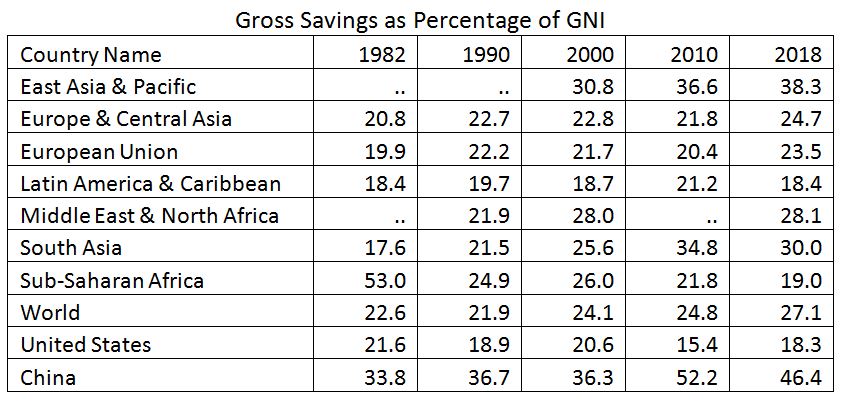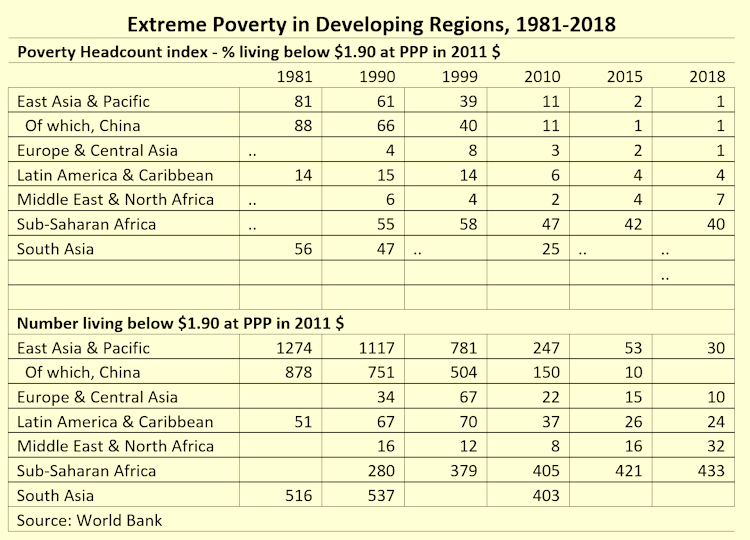|
Economics of the Developing World
I.
Who Are the Poor?
Concentrated
in Sub-Saharan Africa, India, and elsewhere in South Asia. The
Chinese poverty rate was much higher than the developing
country average in 1990, but already much lower than average
in 2005. Income and literacy rates are relatively high in
Latin America, but poverty rates are also high because incomes
are distributed unevenly. With the exception of Sub-Saharan
Africa, all regions met their
Millennium Development Goal of reducing poverty by 50
percent from its 1990 level by 2015. In 2015, the new
Sustainable Development Goals were adopted, calling on nations
to "eradicate extreme poverty for all people everywhere" by
2030. World
Bank projections make it clear that progress toward that
ambitious goal has been interrupted by the COVID-19 crisis.
II.
Obstacles to Development
A. Introduction -
To grow, a country must produce an output beyond its
subsistence needs, and must invest that surplus in productive
means rather than in extravagant consumption, the military, or
civic monuments, or transferring it abroad.
B.
Physical Environment and
Demography- The average developing country has
half the arable land per capita of industrial countries. Most
poor countries are located in tropics, with extremes of heat,
rain, and insects.
Recent research by Spolaore and Wacziarg in JEL finds
that a small set of geographic variables (absolute latitude,
the percentage of a country’s land area located in tropical
climates, whether the country is landlocked or an island) can
account for 44 percent of contemporary variation in log per
capita income, with quantitatively the largest effect coming
from absolute latitude. they also find that countries using
the most advanced technologies in the year 1000 B.C. tend to
remain the users of the most advanced technologies in 1500 and
today, particularly if we correct for their populations’
changing ancestry.
C.
Culture - Economic
development is supported by cultural norms that encourage
honesty, trust, cooperation, hard work, saving (delayed
gratification), honesty, gender and racial equality, and
peaceful resolution of problems. These norms can be
influenced by geography (i.e., separation of people by rivers,
mountains), climate (ability to engage in hard labor), history
(experience with colonialism, slavery, etc.), religion, and
other factors. We have seen recent research by Joseph Henrich
on the religious influence on marriage customs, reducing
tribalism, and strengthening trust and cooperation. Some
"cultural determinists" have noted that most high-income
nations are predominantly Christian or Confucian. They blame
problems of Latin America on an authoritarian culture and
strict brand of Catholicism imported from Spain. Aspects of
Hinduism, such as caste system, may have complicated
development in South Asia, and aspects of Islam, such as the
legal and finance systems, may have slowed the Middle East.
D.
The Economic System -
Some institutional structures retard development. In
many poor countries, absence of fair and effective legal
institutions. Limited monetary exchange. In much
of Africa and Asia, land is held in common or worked on a
sharecropping basis; poor incentive for improvement.
Limited
quality and quantity of financial intermediation in
many developing countries, usually organized around a few
large, heavily regulated banks. Securities markets are
rudimentary. Interest rates are controlled and taxed; provide
small incentive for saving.
E.
Vicious Circles of Poverty
- The population in a poor country cannot afford to invest in
capital goods, education, and health programs that are needed
to promote development. Also, poverty breeds crime,
political instability, and excessive population growth, which
perpetuate poverty..
NOTE:
Jeffrey Sachs of Columbia University has pointed to another
vicious circle. Scientific research tends to follow
market demand, so the technological needs of developing
countries (malaria and AIDS vaccines, tropical biotechnology,
etc.) are neglected. Solution: guarantee a market to
technology firms for developing country needs.
F.
Colonialism, Imperialism, and
Dependency - Most would agree that colonial
rule was often exploitive - even the American Revolution was
prompted by exploitive British taxes. Some would argue
that foreign investment and trade are also exploitive and
promote "dependent development."
UPDATE: According to the research
by Acemoglu, Johnson, Robinson, Europeans adopted more
exploitive, extractive institutions in countries where the
physical environment and health conditions made it difficult
for them to settle. These institutions persisted, they
say, through the years, and now explain approximately
three-quarters of the income per capita differences across
former colonies. Once they control for the effect of
institutions, they find that countries in Africa or those
farther away from the equator do not have lower incomes.
III.
Development Strategies
A.
Laissez Faire vs. Intervention
-- Adam Smith argued that economic
progress is natural. Governments should maintain peace,
sanctity of contracts, administration of justice, and public
projects. Excessive interference will stop economic progress.
In 1940s and 1950s, Ragnar Nurske argued
that growth was stalled by "vicious circles," and Paul
Rosenstein-Rodan argued that a "big push" was
necessary to provide minimum speed or size of investment for
sustained development.
NOTE: As an alternative to the “big push,”
micro-credits:
In 1976, the Bangladeshi economics professor Muhammad Yunus
tried an experiment. From his pocket, he lent the equivalent
of $26 to a group of 42 workers. With that 62 cents per
person, they bought the materials for a day’s work weaving
chairs or making pots. They soon paid back the loan, and Yunus
went on to establish the Grameen
Bank, which launched the microcredit revolution.
In 2006, the Bank and Yunus were awarded the Nobel Peace
Prize, and microfinance has spread throughout the world.
However, the effectiveness of microfinance and many other
micro-interventions (such as distribution of textbooks) has
been called into question by some of the research of Michael
Kremer, Esther Duflo, and Abhijit Banerjee who received the
2019 Economics Nobel for their work on Randomized Controlled
Trials (RCTs) in economic development studies. See our article
by Seema
Jayachandran, describing their work on remedial
education.
On the other hand, the micro-approach of both Yunus and
Kremer/Duflo/Banerjee is criticized by Yao
Yang, who points out that economic growth ultimately
relies on the large-scale savings and investments that were
discussed by earlier authors.

B.
Balanced vs. Unbalanced Growth
-- Nurske argued industrialization requires balanced growth in
all sectors for production balance and because of Say's
Law--the demand for one product is generated by the production
of others. Walt Rostow argued for
unbalanced development of "leading sectors" and Albert
Hirschman emphasized importance of sectors with strong backward linkages (required
industrial inputs) and forward linkages (produces important
industrial inputs).
C.
Import Substitution and Export
Promotion - What industrial sectors should
develop first? Perhaps, begin with products with
demonstrated domestic demand--import substitution.
Hopefully, will reduce payments imbalances, but
distorts allocation of resources and reduces benefits of
comparative advantage. Invites bribery and corruption. Import
reduction decreases demand for foreign currency, raises the
exchange rate, and makes it difficult to market exports.
Instead, export promotion keeps
the nation open to foreign trade, encourages efficiency,
reaps benefits of international specialization, and
imposes cost on inflationary policies and overvalued
exchange rates. On
the other hand, it may increase dependence on foreign trade
(vulnerability to trade wars) and create enclave of exporters
with weak links to the local economy. Part of Washington
Consensus.
UPDATE: Thomas Friedman argues that
Globalization 2.0 was the era of "Reform Wholesale," which
emphasized the top-down macroeconomic provisions of the
Washington Consensus:
- Privatization
of state-owned companies
- Deregulation
of financial markets
- Exchange
rate liberalization
- Openness
and encouragement of foreign direct investment
- Reduction
of trade barriers
- Introduction
of more flexible labor laws
He argues that these are still necessary,
but not sufficient. The flat world of Globalization 3.0
calls for "Reform Retail" which involves a detailed
microeconomic analysis of infrastructure, regulatory
institutions, education, and culture.
UPDATE: Justin Yifu Lin was born in Taiwan, defected to
mainland China (swam from Kinmen Island to Xiamen) in 1979,
later earned a PhD in economics at U. Chicago, returned to
China to teach at Peking University, and served as chief
economist of the World Bank from 2008-2012. Today, at Peking
University, he is Dean
of the Institute of New Structural Economics, which
"maintains that developing countries or regions should
develop industries that conform to their comparative
advantages based on their factor endowments structure. It
seeks synergies between an effective market and a
facilitating government in an effort to achieve economic
transformation and upgrading as well as economic and social
development." In other words, unlike the Washington
Consensus, NS emphasizes that developing countries need to
have robust governmental involvement to address market
failures. With the right mix of policies, Lin has argued,
"Every developing country has the potential to grow
continuously at 8% or more for several decades, and to
become a middle-income or even a high-income country in one
or two generations…".
|
